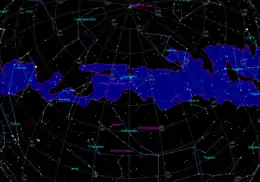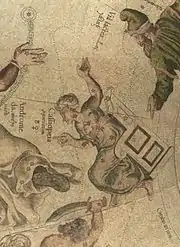Alpha Cassiopeiae
Alpha Cassiopeiae (α Cassiopeiae, abbreviated Alpha Cas, α Cas), also named Schedar /ˈʃɛdɑːr/,[9][10] is a second magnitude star in the constellation of Cassiopeia. Though listed as the "alpha star" by Johann Bayer, α Cas's visual brightness closely matches the 'beta' (β) star in the constellation (Beta Cassiopeiae) and it may appear marginally brighter or dimmer, depending on which passband is used. However, recent calculations from NASA's WISE telescope confirm that α Cas is the brightest in Cassiopeia, with an apparent magnitude of 2.240. Its absolute magnitude is 18 times greater than β Cas, and it is located over four times farther away from the Sun.
 α Cassiopeiae at the bottom right of the "W" | |
| Observation data Epoch J2000 Equinox J2000 | |
|---|---|
| Constellation | Cassiopeia |
| Right ascension | 00h 40m 30.4411s[1] |
| Declination | +56° 32′ 14.392″[1] |
| Apparent magnitude (V) | 2.240[2] |
| Characteristics | |
| Spectral type | K0-IIIa[3] |
| U−B color index | 1.14[4] |
| B−V color index | 1.16[4] |
| Variable type | Suspected[5] |
| Astrometry | |
| Radial velocity (Rv) | −4.31 km/s |
| Proper motion (μ) | RA: 50.88[1] mas/yr Dec.: −32.13[1] mas/yr |
| Parallax (π) | 14.29 ± 0.15[1] mas |
| Distance | 228 ± 2 ly (70.0 ± 0.7 pc) |
| Absolute magnitude (MV) | −2.01[6] |
| Details | |
| Mass | 3.98[7] M☉ |
| Radius | 45.39[7] R☉ |
| Luminosity | 794[7] L☉ |
| Surface gravity (log g) | 1.73[7] cgs |
| Temperature | 4,552[7] K |
| Metallicity [Fe/H] | –0.2[7] dex |
| Rotational velocity (v sin i) | 6.71[8] km/s |
| Age | 220[7] Myr |
| Other designations | |
| Database references | |
| SIMBAD | data |
Nomenclature
α Cassiopeiae (Latinised to Alpha Cassiopeiae) is the star's Bayer designation.
It bore the traditional name Schedar, which was first encountered in the Alfonsine tables of the thirteenth century. It derives from the Arabic word صدر şadr, meaning "breast", a word which is derived from its relative position in the heart of the mythological queen Cassiopeia.[11] Johannes Hevelius used the name Schedir in his writings, although there were additional traditional spellings of this Arabic transliteration such as Shedar, Shadar, Sheder, Seder, Shedis, and Shedir. In 2016, the International Astronomical Union organized a Working Group on Star Names (WGSN)[12] to catalogue and standardize proper names for stars. The WGSN approved the name Schedar for this star on 21 August 2016 and it is now so included in the List of IAU-approved Star Names.[10]
Al-Sufi and Ulug Beg named the star Al Dhāt al Kursiyy (Arabic ذات الكرسي, meaning "the lady in the chair"), which Giovanni Battista Riccioli changed to Dath Elkarti.[11]
In Chinese, 王良 (Wáng Liáng) refers to the Chinese asterism Wang Liang, a famous charioteer during the Spring and Autumn period. The stellar pattern consists of Alpha, Beta, Kappa, Eta and Lambda Cassiopeiae.[13] Consequently, the Chinese name for Alpha Cassiopeiae itself is 王良四 (Wáng Liáng sì, English: the Fourth Star of Wang Liang).[14]
Visibility

With a declination of 56° 32' North, α Cassiopeiae is principally visible in the northern hemisphere. The star is detectable to most observers across the globe reaching as far south as Perth, Australia, Santiago, Chile and other settlements north ± 33° South latitude, albeit close to the horizon. α Cassiopeiae is located in line-of-sight of the Milky Way galaxy, so there are other notable celestial objects one can view close to this star—the Pacman Nebula, NGC 436 and NGC 457 being a few.
Alpha Cas reaches its zenith above cities like Edinburgh, Copenhagen and Moscow. It is circumpolar throughout Europe, Russia, and as far south as Los Angeles, California on the North American continent as well as other locations around the globe having a latitude greater than ± 33° North. Since α Cassiopeiae is listed as a second magnitude star (equal to Beta Cas), it is easily observable to the naked eye as long as one's stargazing is not hindered by the light pollution common to most cities.
The best time for observation is during the late autumn months of the northern hemisphere, when Cassiopeia passes the meridian at midnight, but given its circumpolar nature in many northern localities, it is visible to many of the world's inhabitants throughout the year.
Angular analysis
With the advances in optical interferometry in the 1990s, α Cassiopeiae's angular diameter was measured in 1998 at various wavelengths ranging from 500 to 850 nm. The result was a limb darkened angular measurement of 5.62 ± 0.06 milliarcseconds (mas),[15] a diameter which equates to roughly 0.393 AU or 42.3 R☉, assuming a parallax of 14.29 mas.[16] With the planet Mercury orbiting the Sun at approximately 0.4 AU, α Cassiopeiae's photosphere extends to roughly half the mercurial orbit.
Properties

α Cassiopeiae is a red giant star whose spectral classification is K0-IIIa, notably cooler than the Sun.[3] However, because it is nearing the final stages of its evolution, the photosphere has expanded substantially, yielding a bolometric luminosity that is approximately 800 L☉. It is considered 98% likely to be a horizontal branch star fusing helium in its core.[7]
According to Hipparcos, the New Reduction (van Leeuwen, 2007), the estimated distance to the star is about 70 parsecs or 228 light years.[1] Like all giant stars, α Cassiopeiae rotates slowly with an approximate velocity of 6.7 km/s[8]—a speed which takes the star approximately 102 days to make one complete revolution on its axis.

α Cassiopeiae has been sometimes classified as a variable star, but no variability has been detected since the 19th century.[18] Also, three companions to the star have been listed in the Washington Double Star Catalog, but it seems that all of them are just distant line-of-sight optical components.[19][20][21]
α Cassiopeiae is thought to be around 100 to 200 million years old, having spent much of its time as a blue-white B-type main-sequence star.[18]
Depiction
In 1551, Gerardus Mercator, a Flemish cartographer, produced a celestial globe portraying the 48 traditional Ptolemaic constellations in addition to two others, Coma Berenices and Antinous.[17] On this globe, he represents Cassiopeia as the Queen of Ethiopia, punished for her boasting by being chained to a chair hanging upside-down. α Cassiopeiae is found near her left breast, reflecting its Arabic etymological origin.
References
- van Leeuwen, F (November 2007). "Hipparcos, the New Reduction". Astronomy and Astrophysics. 474 (2): 653–664. arXiv:0708.1752. Bibcode:2007A&A...474..653V. doi:10.1051/0004-6361:20078357. S2CID 18759600.
- Kharchenko, N. V.; Roeser, S. (September 2009). "All-sky Compiled Catalogue of 2.5 million stars". VizieR. Centre de Données astronomiques de Strasbourg. Bibcode:2009yCat.1280....0K. Retrieved 2011-01-06.
- Keenan, Philip C.; McNeil, Raymond C. (1989). "The Perkins catalog of revised MK types for the cooler stars". Astrophysical Journal Supplement Series. 71: 245. Bibcode:1989ApJS...71..245K. doi:10.1086/191373.
- Mermilliod, J.-C. (1986). "Compilation of Eggen's UBV data, transformed to UBV (unpublished)". Catalogue of Eggen's UBV Data. Bibcode:1986EgUBV........0M.
- Samus, N. N.; Durlevich, O. V.; et al. (2009). "VizieR Online Data Catalog: General Catalogue of Variable Stars (Samus+ 2007-2013)". VizieR On-line Data Catalog: B/GCVS. Originally Published in: 2009yCat....102025S. 1. Bibcode:2009yCat....102025S.
- Katz, D.; Soubiran, C.; Cayrel, R.; Barbuy, B.; Friel, E.; Bienaymé, O.; Perrin, M. -N. (2011). "Probing the Galactic thick disc vertical properties and interfaces". Astronomy and Astrophysics. 525: A90. Bibcode:2011A&A...525A..90K. doi:10.1051/0004-6361/201014840.
- Reffert, Sabine; Bergmann, Christoph; Quirrenbach, Andreas; Trifonov, Trifon; Künstler, Andreas (2015). "Precise radial velocities of giant stars. VII. Occurrence rate of giant extrasolar planets as a function of mass and metallicity". Astronomy and Astrophysics. 574: A116. arXiv:1412.4634. Bibcode:2015A&A...574A.116R. doi:10.1051/0004-6361/201322360. S2CID 59334290.
- Hekker, S.; Meléndez, J. (2007). "Precise radial velocities of giant stars. III. Spectroscopic stellar parameters". Astronomy and Astrophysics. 475 (3): 1003. arXiv:0709.1145. Bibcode:2007A&A...475.1003H. doi:10.1051/0004-6361:20078233. S2CID 10436552.
- "Schedar". Merriam-Webster Dictionary.
- "Naming Stars". IAU.org. Retrieved 18 June 2018.
- Richard Hinckley Allen (1963). "Star Names: Their Lore and Meaning". Dover Publications. p. 142. Retrieved 2010-12-31.
- IAU Working Group on Star Names (WGSN), International Astronomical Union, retrieved 22 May 2016.
- (in Chinese) 中國星座神話, written by 陳久金. Published by 台灣書房出版有限公司, 2005, ISBN 978-986-7332-25-7.
- (in Chinese) 香港太空館 - 研究資源 - 亮星中英對照表 Archived 2010-08-18 at the Wayback Machine, Hong Kong Space Museum. Accessed on line November 23, 2010.
- Hajian, Arsen R.; Armstrong, J. T.; Hummel, C. A.; Benson, J. A.; et al. (March 1998). "Direct Confirmation of Stellar Limb Darkening with the Navy Prototype Optical Interferometer". The Astrophysical Journal. 496 (1): 484. Bibcode:1998ApJ...496..484H. doi:10.1086/305388.
- To determine α Cassiopeiae's average radius in terms of solar units, the calculations begin with the formula for angular diameter as follows:
- .
- Gerard Mercator (1512–1594). "Cassiopeia — The Queen". The Mercator Globes at Harvard Map Collection. Archived from the original on 2012-08-17. Retrieved 2011-01-02.
- Professor James B. (Jim) Kaler. "SHEDAR (Alpha Cassiopeiae)". University of Illinois. Archived from the original on 27 March 2010. Retrieved 2010-02-22.
- Brown, A. G. A.; et al. (Gaia collaboration) (August 2018). "Gaia Data Release 2: Summary of the contents and survey properties". Astronomy & Astrophysics. 616. A1. arXiv:1804.09365. Bibcode:2018A&A...616A...1G. doi:10.1051/0004-6361/201833051. Gaia DR2 record for this source at VizieR.
- Brown, A. G. A.; et al. (Gaia collaboration) (August 2018). "Gaia Data Release 2: Summary of the contents and survey properties". Astronomy & Astrophysics. 616. A1. arXiv:1804.09365. Bibcode:2018A&A...616A...1G. doi:10.1051/0004-6361/201833051. Gaia DR2 record for this source at VizieR.
- Brown, A. G. A.; et al. (Gaia collaboration) (August 2018). "Gaia Data Release 2: Summary of the contents and survey properties". Astronomy & Astrophysics. 616. A1. arXiv:1804.09365. Bibcode:2018A&A...616A...1G. doi:10.1051/0004-6361/201833051. Gaia DR2 record for this source at VizieR.
External links
- Harvard Map Collection The Mercator Globes
- The Internet Encyclopedia of Science: Shedar (Alpha Cassiopeiae)